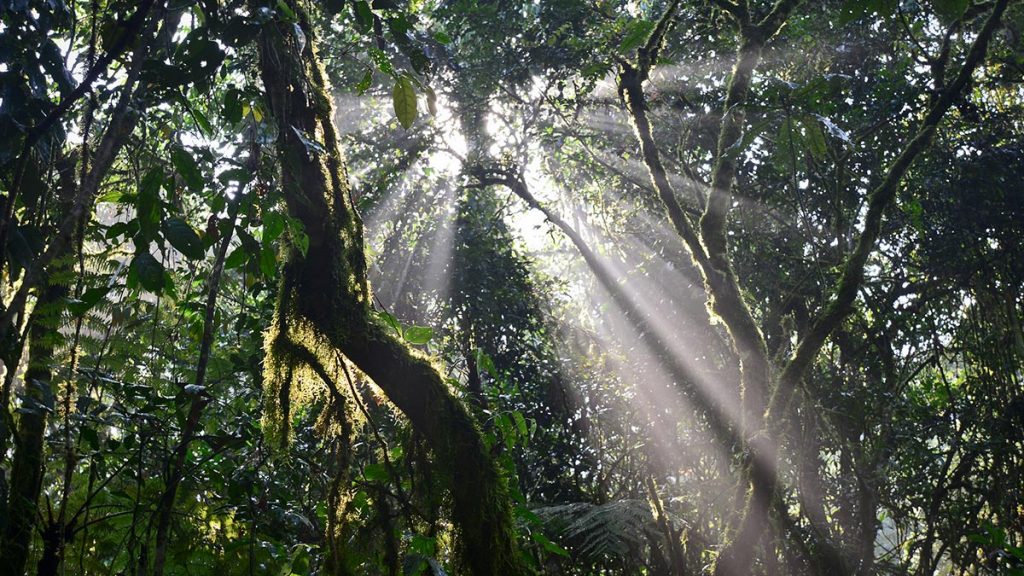
Bwindi Impenetrable Forest National Park
Blanketing the Southwestern corner of Uganda’s border with congo at the edge of the Albertine Rift Valley, Bwindi Impenetrable National Park is houses one of Uganda’s oldest and most biologically diverse rainforests, which dates back over 25,000 years and contains almost 400 species of plants. More famously, this “impenetrable forest” also protects a little more than 400 mountain gorillas – roughly more than half of the world’s population of 1008 individuals, including several habituated gorilla groups available for the gorilla tracking adventure.
This biologically diverse region also provides shelter to a further 120 mammals, including several primate species such as baboons and chimpanzees, as well as elephants and antelopes. There are around 350 species of birds hosted in this forest, including 23 Albertine Rift endemics.
The neighboring towns of Buhoma and Nkuringo both have an impressive array of luxury lodges, rustic bandas and budget campsites, as well as restaurants, craft stalls and guiding services. Opportunities abound to discover the local Bakiga and Batwa Pygmy cultures through performances, workshops and village walks.
Areas of Tourism Interest in Bwindi
Buhoma Sector
Located to the northwest of Bwindi Impenetrable Forest and facing the dark, hilly forests, the Buhoma sector has three gorilla groups that can be tracked and there are also community-run village walks for exploring the culture and lifestyle of the local Bakiga and Batwa tribes.
Bird watching is also a major activity with great opportunities to see various Albertine Rift endemics such as the Short-tailed Warbler. Other activities include mountain biking and nature walks to waterfalls and parts of the forest. There are also numerous accommodations to suit all budgets and many local craft stalls.
Nkuringo Sector
Nkuringo, on the southern edge of the park, became Bwindi’s second gorilla tracking trailhead in 2004. Tracking the Nkuringo groups is strenuous, for their forest home lies a full 600m below the trailhead at Ntungamo village on Nteko ridge. Walks along the ridge-top road provide superb views north towards the forested hills of Bwindi and south to the Virunga volcanoes. There are also opportunities to discover the Bakiga culture through village walks, vibrant dance performances and cultural workshops organized by community groups.
Rushaga Region
Shongi trailhead, in the southeast of the park opened for gorilla tourism in 2009. Three groups (Shongi, Mishaya and Kahungye) can be tracked from this point. The trail descends into the depths of the forest directly to the south of the park. Furthermore, this area offers village walks, bird watching and a spectacular waterfall.
Ruhija Sector
On the eastern side, sitting on top of the hill at 2,345m, Ruhija is home to the Bitukura, Oruzoojo and Kyaguriro gorilla groups. This is Uganda’s highest tracking trail, and one of only two areas (the other being Rushaga) where elephants reside. A six-hour bamboo trail leads to Rwamunyoni Peak; at 2,607m, it is the highest point in the park and notable for good birding. Also of interest to birders is the three-hour trail descending to Mubwindi swamp along which one could find the endemic and localized African Green Broadbill.
Nyundo Region
This community, a short drive north of Buhoma, sits on the DR Congo border and offers wonderful guided hikes along the hill crests and rivers to discover waterfalls, glorious views, and the traditional lifestyle and folklore of the Kigezi people.
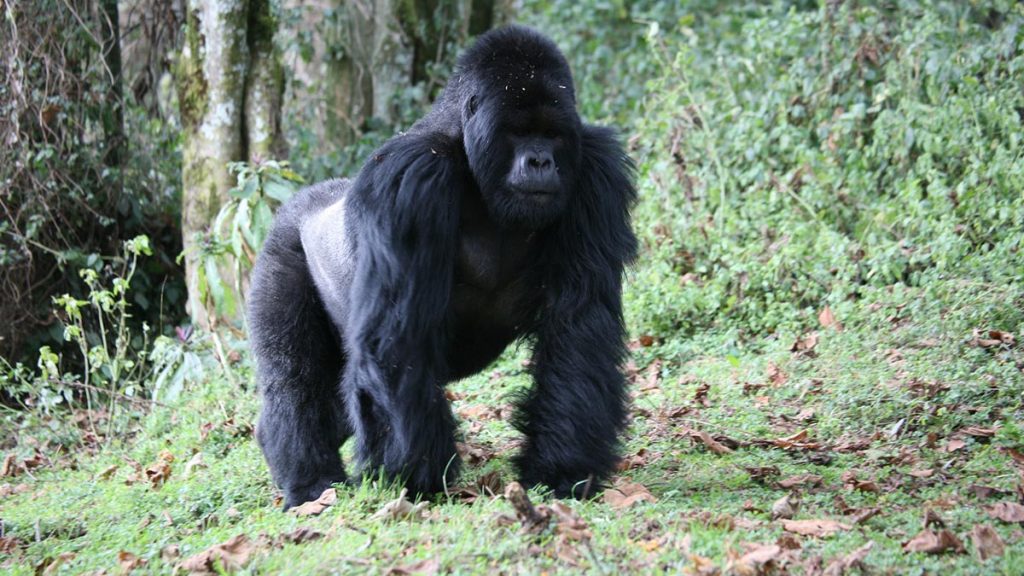
Wildlife and Birding Summary
Mountain Gorillas
Bwindi Impenetrable Forest has a population of around 400 gorillas of which an estimated 116 are habituated. Gorillas are intelligent, majestic, gentle giants that share over 90% of their genetic material with humans. All of Bwindi’s habituated gorillas are known individually by the rangers and have been given names in order to identify them. The males can weigh more than 500lb and some silverbacks exceed 6ft!
Other Forest Species
There are least 120 mammal species living in the Bwindi forest, making Bwindi second only in mammal numbers to the vast Queen Elizabeth National Park. The eleven primate species found here include black-and-white colobus and L’Hoest’s monkeys, baboons and chimps. There are also forest elephants and several species of antelopes. Of Bwindi’s 200 butterfly species, 42 are endemic to the Albertine Rift.
Birds and Bird Watching
Bwindi Impenetrable Forest offers some of the finest montane forest bird watching in Africa, and is an unmissable destination for any birder visiting Uganda. There are an estimated 350 bird species with 23 endemic to the Albertine Rift and 14 recorded nowhere else in Uganda. Globally threatened species such as African Green Broadbill and Shelley’s Crimsonwing are also found here. Other birds include the Handsome Francolin; Black-billed Turaco; African Broadbill; Black and Cinnamon-chested Bee-eaters; Western Green Tinkerbird; Purple-breasted, Blue-headed and Regal Sunbirds; Short-tailed and Black-faced Rufous Warblers; Mountain-masked and Collared Apalis; Mountain and Yellow-streaked Greenbuls; and Many-colored Bush-Shrike, among others.
Activities in Bwindi Impenetrable Forest
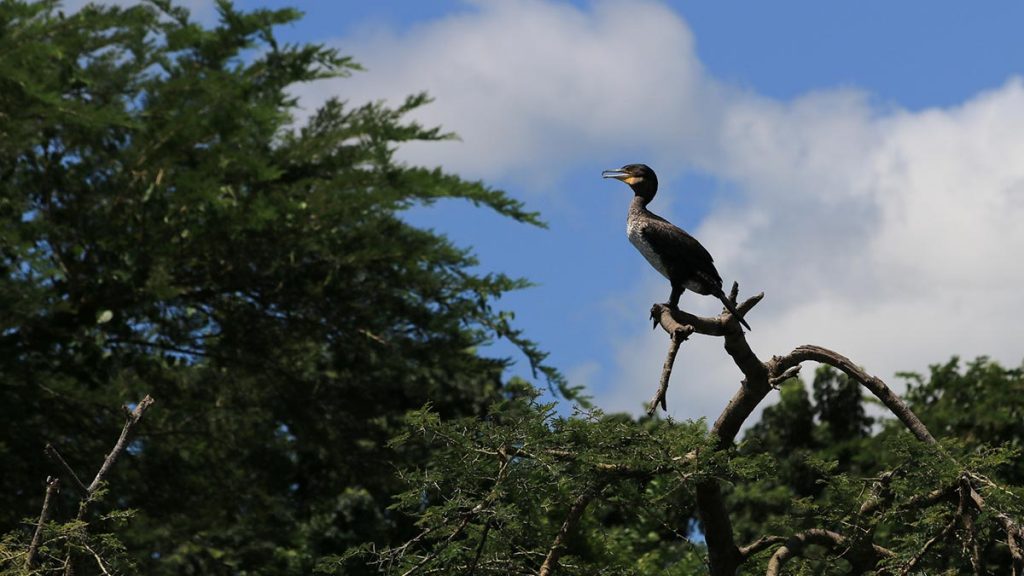
Birding/Bird Watching
The varied habitats of Uganda’s oldest forest mean it is the ideal habitat for a variety of birds, with 350 species recorded, including 23 endemics (90% of all Albertine Rift endemics) such as the Short-tailed Warbler and Blue-headed Sunbird as well as seven IUCN red data listed species. Easy to see are the African Emerald Cuckoo, Common Bulbul, African Blue and White-tailed Blue Flycatchers and Red-headed Bluebill.
Birding takes place along the main trail, the Buhoma Waterfall Trail and along the bamboo zone and Mubwindi Swamp trail in Ruhija
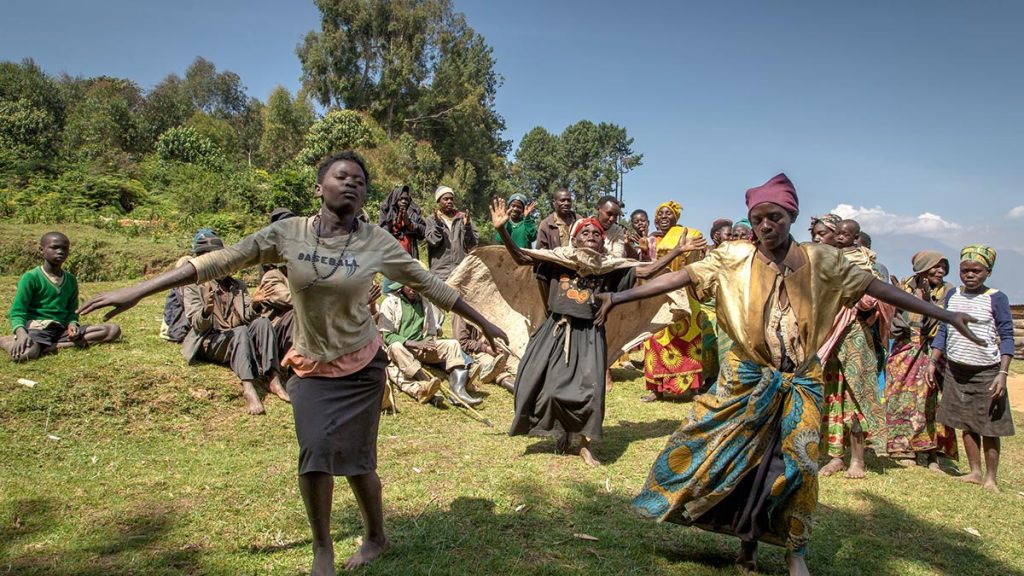
Cultural Encounters
Explore the culture of the local Bakiga and Batwa communities with village walks, blacksmith visits, craft shops and vibrant dances – all against the astounding backdrop of the forest-covered hills of Bwindi Impenetrable Forest.
Buhoma Community Tours
Overlooking the imposing hillsides of Bwindi Impenetrable forest, with mist swirling over the summits, Buhoma is a truly dramatic setting for your cultural tour!
The three-hour village walk begins with a visit to the handcraft shop – selling handmade artifacts such as fabrics, beeswax candles and wood carvings, all produced by talented local craftsmen and women. The neighboring Batwa community performs songs and dances about their former life in the forest, introducing you to another unique local culture. You will also meet the traditional healer who treats the sick with medicinal plants, and the teachers and pupils of the local primary school. Finally, you can learn how bananas are used to make juice, beer and gin – and taste the results!
Proceeds from the tour support community development projects such as a secondary school, maize mill and microfinance circle, and the Batwa receive all proceeds from their performances.
Nkuringo Community Conservation and Development Foundation (NCCDF)
Set in a lush hillside bordering Bwindi Impenetrable Forest with dramatic views towards Congo, Nkuringo is a wonderful place to visit for those who want both a cultural experience and beautiful scenery.
A visit to Nicholas the blacksmith rewinds time to the Stone Age with the sound of sheepskin bellows spewing air into a charcoal-fired furnace, from which Nicholas hooks out red hot metal and hammers it into tools; from knives to machetes. Sesilia welcomes you into her home – a series of traditional huts housing a millet-grinding stone, cooking pots and apparatus for distilling local waragi banana gin. Pena is the village´s traditional healer who uses native plants to make tea, ointments and herbal powders that cure a range of ailments.
NCCDF supports local artisans and the local Batwa community through its crafts shop. They train orphans who perform at a nearby lodge, and can make arrangements for visitors to sponsor them.
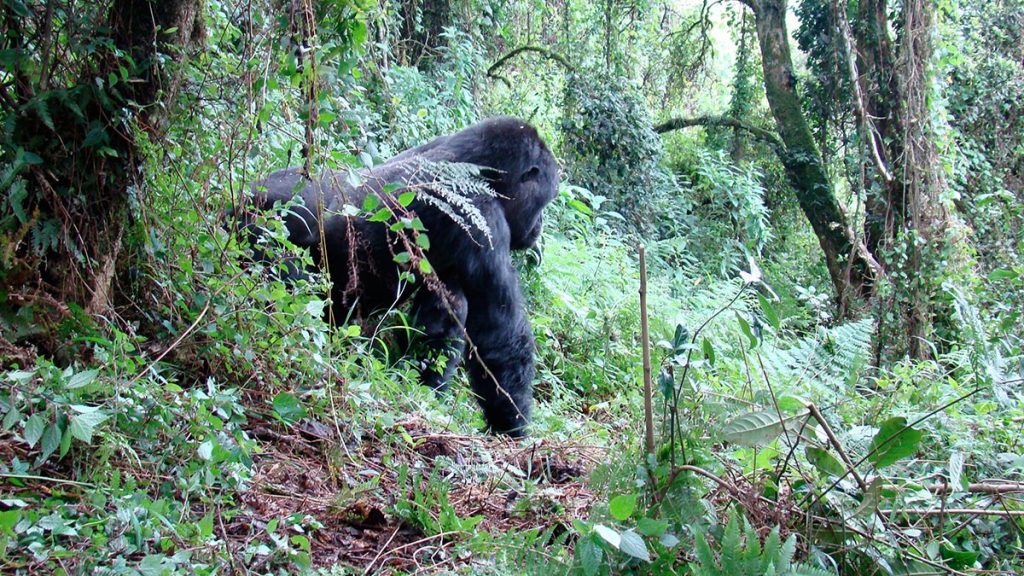
Gorilla Tracking and Jungle Trekking
It is a humbling experience to stand just meters from man’s distant cousins as they eat, rest, play and bond with their young. Gorilla trekking takes place in four locations, starting at 8:30am daily.
Gorilla Safari: Uganda Mountain Gorillas & Wildlife Tour 5 Day
Following a briefing, visitors embark on a forest trek lasting from a few hours up to a full day, depending on the location of the gorillas as they range freely in the impenetrable forest. Tours are limited to a maximum of eight people and visitors spend a maximum of one hour in the company of the gorillas in order to minimize behavioral disturbance and risk of disease transmission.
Buniga Forest Nature Walk
Discover the gorgeous hidden treasures of Buniga Forest and its diverse flora and fauna on this trail, led by locals who are expert regional guides. Buniga Forest Reserve is one of the three remaining pocket forests adjacent to Bwindi Impenetrable National Park. Due to the increased encroachment on the forest and associated loss of biodiversity and other forest resources, the trail was created by Nkuringo Community Conservation and Development Foundation (NCCDF) to protect the forest and manage it for ecotourism activities. As well as protecting this precious forest, proceeds from the tour also benefit surrounding communities, and encourage them to actively participate in its conservation.
Nkuringo Cultural Centre (NCC)
Why not learn a new skill during your trip to Uganda? At Nkuringo Cultural Centre, after a long day spent tracking gorillas or bird watching, you can enjoy one of our fascinating cultural evening workshops. Choose from African cooking, traditional weaving, or – for those who are feeling a little more energetic – a dancing and drumming workshop is available.
You can also take one of our guided village walks during the day to meet the residents, learn about life in Rubuguri and participate in a crafts demonstration. You will then visit the primary school to watch this region´s most famous cultural attraction – the dynamic Kiga dance. The best dancers are said to be those who
Nyundo Community Eco-Trails
Nyundo’s residents were firsthand witnesses to climate change. They cultivated crops on the hillsides bordering Bwindi Impenetrable forest, but noticed erosion, changing rain patterns and the disappearance of the characteristic mist. Ultimately, their crops began to fail. The community decided to protect the land and allow the forest to grow back, and now the trees, the rains and the mist have all returned.
Nyundo Community Eco Trails were developed by community members as a sustainable alternative to agriculture, poaching and logging; providing both an income and an incentive to conserve the forest.
On King Bakyara’s Waterfall Trail, enjoy spectacular scenery surrounding a waterfall where only kings may bathe! Visit a blacksmith, a local banana beer distillery, a beekeeper, a cattle farm and a banana plantation.
During the Traditional Skills Trail, learn about millet-bread preparation, yoghurt making and craft making. Visit a traditional birth attendant and traditional homesteads, and meet the friendly villagers.
Conservation Through Public Health (CTPH)
Conservation Through Public Health (CTPH) is a grassroots organization that has improved the health of wildlife, livestock and some of the poorest people in Africa. In Buhoma, visitors can take a tour of the Gorilla Health Centre to learn about their health and how diseases are transmitted between wild animals and livestock, as well as other conservation issues addressed by CTPH.
Tour the Village Aquaponics project where you will learn about sustainable methods of farming fish, which is then sold to local lodges. If booked in advance, CTPH staff can also offer presentations on conservation issues in Bwindi and guided tours of local communities to demonstrate how improving the health and livelihoods of people and their livestock supports the conservation of gorillas.
Rubuguri Village Walk (NCC)
Reached by rustic roads running around steep hillsides, this small community makes up for its isolation with the warm welcome of its inhabitants. The Village Walk takes you past a swamp to a small homestead, where you will have the chance to meet the residents and learn about life in Rubuguri, as well as participate in a crafts demonstration.
You will then visit the lively St Peter´s Primary school to meet the pupils and teachers, and to watch this region´s most famous cultural attraction – the dynamic Kiga dance. The best dancers are said to be those who make the earth shake – and as the barefooted students leap several feet into the air to the rhythm of joyful songs you will be able to decide for yourself if they achieve their goal!
Cycling/Mountain Biking
Mountain biking follows a well-maintained trail from the park headquarters at Buhoma to the Ivi River. Along this 13km trail you may see wildlife such as bushbucks, black-and-white colobus and red-tailed monkeys. The six-seven hour round trip departs in the morning, and is organized by Buhoma Community Rest Camp under the “Ride for a Woman“community development initiative.
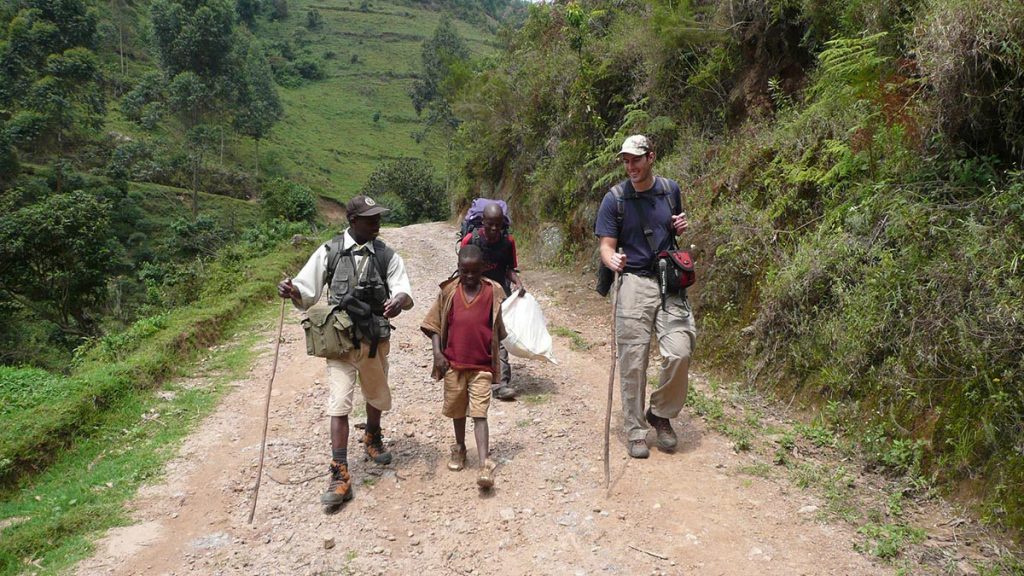
Hiking/Nature Walks
There are six main nature trails in Buhoma for those who wish to explore the “impenetrable forest”:
Muyanga Waterfall Walk departs from Buhoma along the River Ivi-Nkuringo trail and culminates in the sensational sight of the falls plummeting 33 meters.
Rushura Hill Walk passes through one forest shared by two countries. On a clear day you can view Lakes Edward and George and the Rwenzori Mountains as well as the conical peaks of the Virunga Volcanoes.
Muzubijiro Loop is a 6km walk around a hill, where you will encounter primates and birds and enjoy a view of the Virungas.
The Ivi River Walk is 14km and takes around seven hours. The trail passes a place known as Mukempunu – meaning “a place of pigs” – where wild pigs can often be found.
The Buhoma-Nkuringo Trail takes three to four hours, and crosses right through the park, connecting the two villages and offering impressive views of the misty hillsides as you ascend the hills towards Nkuringo. This trail can also be completed as part of the Ivi River Walk.
The Habinyanja (Railegh) Trail takes 4-6hrs. After crossing the Munyaga River, it takes in a fairly steep ascent of the Habigorogoro and Riyovi Ridge overlooking Buhoma River. Found along this trail is the legendry “African Corner” named after a rock piece depicting a map of Africa. Following the steep ascent, keen hikers can enjoy a more relaxed gentle slope to the mighty Habinyanja swamp. Birders on this trail should watch out for the Pel’s Fishing Owl, African Black Duck and Black Bee Eaters, among others.
Location: Kanungu District, Uganda
Nearest city: Kanungu
Coordinates: 01°01′S 29°41′ECoordinates: 01°01′S 29°41′E
Area: 331 km2 (128 sq mi)
Established: 1991
Governing body: Uganda Wildlife Authority
UNESCO World Heritage Site
Type: Natural
Criteria: vii, x
Designated: 1994 (18th session)
Reference no.: 682
State Party: Uganda
Region: Africa
